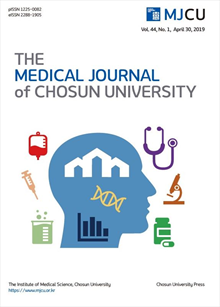간행물
The Medical Journal of Chosun University 조선대학교 의대논문집

- 발행기관 조선대학교 의학연구원
- 자료유형 학술지
- 간기 반년간
- ISSN 1225-0082 (Print)2288-1905 (Online)
- 수록기간 2013 ~ 2019
- 주제분류 의약학 > 의학일반 의약학 분류의 다른 간행물
- 십진분류KDC 510DDC 610
권호리스트/논문검색
Vol. 40 No. 2 (2015년 6월) 9건
1.
2015.06
서비스 종료(열람 제한)
2.
2015.06
서비스 종료(열람 제한)
Hye Shin Ahn, Yong Sun No, Ju Hyun Seo, Jong Bum Kwo, Khun Park, Mahn Won Par, Jung Sun Cho, Chan Joon Kim, Gyoung Min Park, Tae Seok Kim, Sung Ho Her
Diffuse involvement of the right pulmonary artery (PA) associated with fistula between the PA and coronary artery is report-ed in a woman with Takayasu’s arteritis. Both the subclavian arteries were totally occluded and drained by the meanderinged artery arising from both common carotid arteries. Lung perfusion scan revealed perfusion defect of right lung. Two fistulas were identified. A large fistula was between the right PA and left circumflex artery. A small fistula was between the right PA and left anterior descending artery. This is a rare case of Takayasu’s arteritis presenting with a coronary – pulmonary artery fistula that is secondary to a diffuse unilateral involvement of PA.
3.
2015.06
서비스 종료(열람 제한)
Mannitol is commonly used to reduce intracranial and intraocular pressures and to prevent dialysis-disequilibrium syndrome. However, intravenous mannitol infusion in various cases has the potential to result in acute kidney injury (AKI). We present a case of mannitol-induced AKI that developed after low dose mannitol infusion and resulted in recovery after hemodialysis. A 66-year-old woman was admitted to the hospital with a diagnosis of left middle cerebral artery infarction. On hospital day 5, cerebral edema was observed on a follow-up MRI. D-mannitol 35 g was given intravenously every 8 hours. Four days later, serum creatinine levels were elevated from 1.2 mg/dL to 3.5 mg/dL. The serum osmolal gap was found to be 52.4 mosm/kg H2O and urine output was reduced from 2.78 mL/kg/h to 0.69 mL/kg/h over three days. Hemodialysis over 2 hours was performed and renal function subsequently improved to baseline function. A potential risk of AKI exists even with low dose mannitol infusion in patients with advanced age, underlying renal impairment, and concomitant use of nephrotoxic agents. Mannitol-induced AKI may be rapidly reversed by short-term hemodialysis.
4.
2015.06
서비스 종료(열람 제한)
Toxocariasis is an illness of humans caused by roundworm. Toxocara species are commonly found in dogs and cats. Humans are accidental hosts. There are two routes of infection. One route is the ingestion of infected eggs, and the other route is the ingestion of an infected paratenic host. Clinical manifestations vary from asymptomatic infection to severe organ failure. In most cases, the patients are asymptomatic and the disease is self-limited. Thus, patients with mild symptoms do not require treatment. However we report on cases of patients with asymptomatic hepatic nodules who were treated to exclude malig-nant disease.
5.
2015.06
서비스 종료(열람 제한)
Syphilis is a sexually transmitted infection caused by Treponema pallidum. Ocular involvement is rare and diagnosis of ocular
syphilis is challenging due to nonspecific symptoms. The diverse manifestation of ocular syphilis occurs as well in secondary
as in tertiary syphilis, for it can affect all structures of the eye; corneoscleral, uveal, retinal, and optic nerve inflammation
may be observed. We report on a case of ocular syphilis affecting the vitreous body in a 43-year-old healthy male
with a 6-month history of diminished visual acuity in the left eye.
6.
2015.06
서비스 종료(열람 제한)
This is the case report of a 58-year-old man who developed acute severe hypoglycemia after a spinal block. He had a history of injecting insulin combined with 50% dextrose for hyperkalemia control. After the spinal block, he presented with hypo-glycemic symptoms and went into convulsions. Following injection of midazolam and 10 ml of 50% dextrose, his mental state returned to alert. We recommend careful monitoring of blood sugar level of chronic kidney disease patients who under-go neuraxial block.
7.
2015.06
서비스 종료(열람 제한)
Spontaneous rupture of the carotid artery is rare, however, it is a fatal injury and early diagnosis is very important. We expe-rienced a 54-year-old male patient who presented to the emergency department with an expanding neck mass after cough. Rupture of the common carotid artery 2 cm before bifurcation with a pseudoaneurysm was diagnosed on neck computed tomography angiography. Focal tear of the artery was repaired surgically with suture. Herein, we report on a rare occurrence of a spontaneous carotid artery rupture and review other reports.
8.
2015.06
서비스 종료(열람 제한)
A 31-year-old woman was transferred because of dyspnea that occurred immediately after cesarean section. Initial echocar-diography showed akinesia in apex to mid left ventricular (LV) wall with severe LV systolic dysfunction, which was pre-sumed to be stress-induced cardiomyopathy. Because the patient developed cardiogenic shock, we initially planned on inser-tion of an intra-aortic balloon pump. However, due to aggravation of cardiogenic shock and pulmonary edema, we had to resort to extracorporeal membrane oxygenation (ECMO) for cardiopulmonary support. In addition, an LV pigtail catheter was applied for decompressing the LV. Finally, she was successfully weaned from ECMO after recovery of LV function.
9.
2015.06
서비스 종료(열람 제한)
Paraneoplastic neurological syndromes (PNS) are the remote effects of cancer on the nervous system. These may affect the nervous system from cerebral cortex to neuromuscular junction and muscle, causing damage to one or multiple areas. Among the various papraneoplastic neuropathies, the classical syndrome of PNS is subacute sensory neuronopathy involving the sensory neuron cell bodies in the dorsal root ganglia. In general, cases with paraneoplastic sensory neuronopathy are associated with small cell lung cancer. The authors experienced a case of an atypical unilateral paraneoplastic sensory neu-ronopathy associated with primary breast adenocarcinoma and lung metastasis, which is worthy of reporting.

